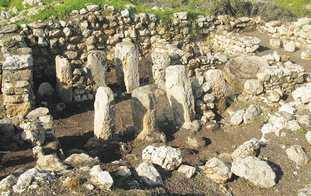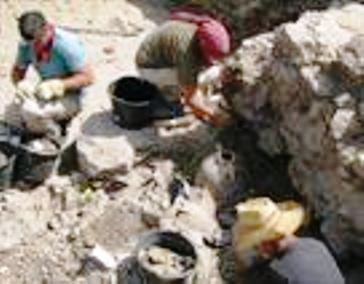Home from Biblical Kingdom Of Israel Discovered on Haifa Coast
Tzvi Ben Gedalyahu
Source - http://www.israelnationalnews.com/News/News.aspx/145369
A well-preserved, 3,000-year-old four-room house from the Biblical Kingdom of Israel has been discovered on Haifa’s southern coast by University of Haifa archaeologists.

Credit Shay Bar / Univ. of Haifa
They also found remains of a Persian city, dating back 2,400 years, and of a 1,500-year-old Byzantine town. The discoveries at the Shikmona Nature Reserve site involved what experts said was detective work, due to the site's having been excavated 42 years ago but since covered with garbage and earth.
Archaeologists from Haifa University re-examined the structure and were amazed to find that it had remained well preserved and is in fact the best-preserved "Four-Room House" dating back to that period known today.
"We had seen the structure in the old photographs, and were sorry that such a rarely preserved finding had disappeared due to neglect. We were not even sure that we would be able to find it again. It was practically a miracle that we managed to locate and uncover it and that it is still so well preserved," said Dr. Shay Bar and Dr. Michael Eisenberg of the Zinman Institute of Archaeology at the University of Haifa, who headed the excavation team.

Old photographs of the 1970s excavations show a house dating back to the 8th-9th centuries BCE, which is the period of the Kingdom of Israel.
The structure's design of a "four-room house,” the most common design for houses in that era, is characterized by the functional division of the structure into four living spaces: three positioned vertically and the fourth horizontally. The other four-room houses exposed to date have been found in relatively bad condition.
Detective work based on the photographs led the researchers to estimate the location of the house – and luck was on their side as they located the structure and also found it highly preserved.
The archaeologists said that the discovery presents a rare opportunity to study and become familiar with everyday life in the days of the Kingdom of Israel. They hope to include the structure in the public archaeological park.
An additional rare find exposed during the excavations belonging to the period of the Kingdom of Israel is a personal seal showing an inscription in Hebrew or Phoenician. The researchers hope that deciphering this inscription will give the answer to whether the settlement of that time was in fact Israelite or Phoenician.

ECR 100 : Introduction aux écritures anciennes / Introduction to ancient writing systems
Other findings from that period give evidence of expansive trade with Middle Eastern neighbors. These include relics imported from Cyprus and the coast of Lebanon, which arrived in fine, delicate vessels of high-quality ceramic. Also exposed were remains of purple-colored pitcher shards.
The researchers explain that these are likely to be rare cases of preserved dye, which is reinforced by the fact that hundreds of the purple dye-producing mollusc shells were also found at the site.
At the site of the Byzantine house, a number of destroyed mosaic floors and storage rooms were uncovered, while dozens of vessels there survived the ruins and were found whole. Many coins, ornaments, pendants, weapons and glass vessels were also found there, providing evidence of the wealth of the inhabitants.
Underneath the remains was the Persian era structure, at which an oven, clay loom weights and storage pitchers were found, indicating Persian settlement of the area.